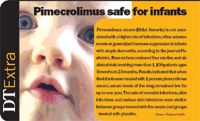- Acne
- Actinic Keratosis
- Aesthetics
- Alopecia
- Atopic Dermatitis
- Buy-and-Bill
- COVID-19
- Case-Based Roundtable
- Chronic Hand Eczema
- Chronic Spontaneous Urticaria
- Drug Watch
- Eczema
- General Dermatology
- Hidradenitis Suppurativa
- Melasma
- NP and PA
- Pediatric Dermatology
- Pigmentary Disorders
- Practice Management
- Precision Medicine and Biologics
- Prurigo Nodularis
- Psoriasis
- Psoriatic Arthritis
- Rare Disease
- Rosacea
- Skin Cancer
- Vitiligo
- Wound Care
Article
Understanding geriatric dermatology
San Francisco ? Treating the 65 and older patient is becoming a growing issue in dermatology. While some 35 million Americans ? about one in every eight people ? are elderly today, the senior population is expected to increase to one in five people, or an estimated 70 million, by 2030, according to Wendy E. Roberts, M.D., a dermatologist in Rancho Mirage and assistant clinical professor of medicine at Loma Linda University Medical School, Loma Linda, Calif.
San Francisco - Treating the 65 and older patient is becoming a growing issue in dermatology. While some 35 million Americans - about one in every eight people - are elderly today, the senior population is expected to increase to one in five people, or an estimated 70 million, by 2030, according to Wendy E. Roberts, M.D., a dermatologist in Rancho Mirage and assistant clinical professor of medicine at Loma Linda University Medical School, Loma Linda, Calif.

Aging and the skin
"In addition, the immune system decreases with aging," she says. "And that makes the 65-year-old and older patient more vulnerable to infections and internal malignancy."
A study by Borkan and Norris in 1980, published in the Journal of Gerontology, drew an important association between inner and outer health. Researchers looked at 10,086 men and 24 physiologic parameters, such as blood pressure, renal function and pulmonary function tests, and found that individuals who appeared chronically older were also biologically older, with more abnormal parameters.
"The people who looked the oldest were in worse medical health. And those who looked the oldest and had the more abnormal parameters took the longest to heal wounds," Dr. Roberts says. "So it is important for dermatologists to not only focus on skin rejuvenation and wrinkle reduction, but also educate our patients about the importance of general physical health, exercise and nutrition in maintaining a youthful, healthy life."
Skin disorders
The 10 most common skin disorders among the elderly (in the order of prevalence) are: xerosis, pruritus, solar lentigo, seborrheic keratosis, dermatitis, actinic keratosis, nonmelanoma skin cancer/lentigo- maligna melanoma, solar purpura, alopecia and rosacea.
Under the umbrella of dermatitis, drug eruptions are not only more common among elderly patients but also have variable, unusual presentations and can easily be misdiagnosed, Dr. Roberts says. These reactions include photosensitivity and bullous eruptions.
"Often, in order to properly diagnose a drug eruption, you have to go through the patient's medication list - not only with the patient but also with the patient's spouse or family member. I ask many of my patients to bring in all their medications," she says.

Rosacea is a common disorder among the elderly and may result from sun damage and vascular dilatation, according to Dr. Roberts. Dermatologists should educate elderly patients about the importance of using sunscreen when they have the condition.
"I look for it on every facial exam of elderly patients," she says.
Newsletter
Like what you’re reading? Subscribe to Dermatology Times for weekly updates on therapies, innovations, and real-world practice tips.
















